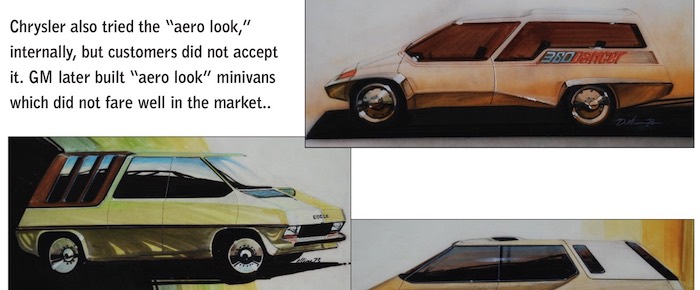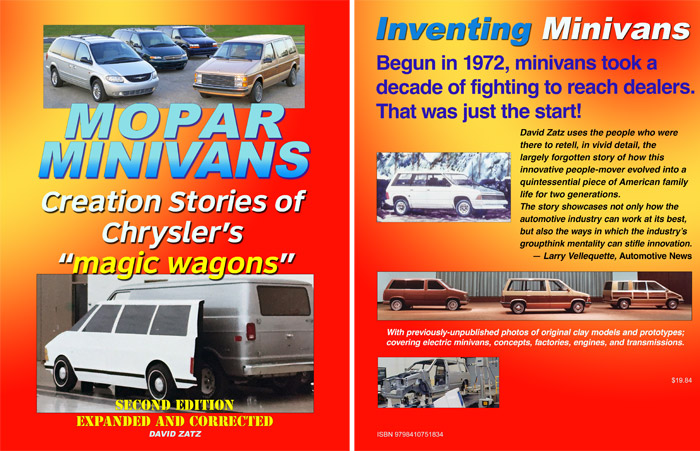The minivan famously arrived in 1983, for the 1984 model year, starting with a Mitsubishi-engined Plymouth Voyager which was followed by a Dodge Caravan*. But it could have started by 1976 or 1977.
According to artist Dennis Kline, minivan work started around 1972. It was originally to be based on the B-vans, but they quickly realized this would not work; likewise, they tried the “aero look” and various “custom van” themes that they also discovered would not work on smaller vehicles. These Dennis Kline pieces (from the book Mopar Minivans, Second Edition) show some of his early 1972-73 minivan work; the book has six different renderings from that period.

Product planner Burt Bouwkamp reportedly supported the project, but executives at that point did not want to try anything not already proven by GM and Ford, so they rejected the project—and kept rejecting it until Lee Iacocca was in charge, and even he rejected it at first. Bouwkamp moved to Chrysler Europe shortly afterwards, where he pushed the idea of Matra, a small engineering firm that modified SIMCA vehicles into, as one example, the Rancho crossover. Matra built a prototype; but then Peugeot bought SIMCA, and Matra had to put their idea out to other automakers. Renault bit, and the European-standard minivan, the Espace, would be born at about the same time as the Voyager and Caravan.
The minivan was hailed when it arrived as a remarkable achievement, despite being slow and somewhat obviously based on the economy Reliant; this was before crossovers and most SUVs, and a fuel-efficient vehicle with its absurd amount of interior space, comfort, and flexibility was revolutionary. It had roughly the footprint of a Reliant but more space than any sedan (or probably any wagon) the company had ever made. Sales got to the point that two full-sized assembly plants were needed; and since it sold at a premium price and had a strong resale value for many years, it was a true financial winner as well.

Today, the minivan market has faltered. Chrysler itself lost dominance some years back to Toyota or Honda, depending on the year, and though it has regained its lead, the market is quite small. One reason is because the original size minivan is long gone; today’s is only sold in a “grand” size and a price to match. But the company this week celebrated forty years of the minivan, that project which was rejected by executives for years before finally getting approval from Lee Iacocca—and hundreds of thousands of buyers per year for quite some time.
The second edition of Mopar Minivans covers every generation of the Chrysler “garageable vans,” from the early development of the 1970s to the mules of the 1980s to the Pacifica of today. It has been expanded from the original edition with, among other things, corrections to and expansion of the electric minivans, and more stories from generations beyond the first series.
* Chrysler has reportedly rebadged the same vehicle depending on whether they needed it to be a Dodge or a Plymouth; when Plymouth was dropped, the first minivan was purportedly a Dodge Caravan. Now that the Caravan is Canada-only and the Voyager name has returned, the first minivan is back to being a Plymouth Voyager.
Mopar Minivans, Second Edition is currently on sale for $6.36 (Kindle) or $15.80 (print; $19.84 in Canada).
